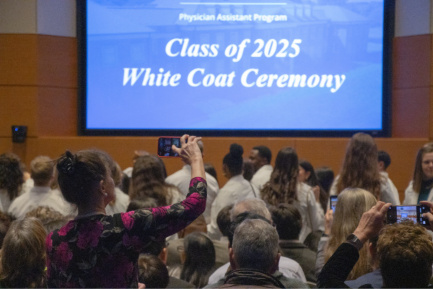Duke PA Programs Celebrates Class of 2025 at White Coat Ceremony

The Duke Physician Assistant (PA) Program held its traditional white coat ceremony for the Class of 2025 on January 5th, 2024.
Last year, the program shifted from an August ceremony to the current January ceremony, a move students say made the event more meaningful because by the end of the fall term, they had bonded with their classmates and developed relationships with the faculty and staff. Rather than receiving white coats and storing them until the spring semester, the January celebration coincides with the beginning of students’ in-hospital experience in which they will wear their white coats while shadowing preceptors and learning some basics of hospital medicine.
The “lights out” class
The class of 2025 started off the school year surrounded by fallen trees and broken power lines. The day before students arrived for orientation, a severe storm tore through the area with straight-line winds and gusts of more than 70 miles per hour. Nearly every neighborhood lost trees, and more than 100,000 people and businesses, including the Duke PA Program, were without power.
In her opening remarks, Division Chief and Program Director Jacqueline Barnett, DHSc, MSHS, PA-C, referred to the class of 2025 as the “lights out” class and joked, “I pin them with this endearing name because we believe the excitement, intensity, and joules of energy that they brought to the program upon arriving in August 2023 short-circuited the power system and we were without power for 30 hours during the week of orientation.”
Barnett is proud of the manner in which the faculty, staff, and students navigated this inauspicious start.
“The fabulous thing is that the class continues to bring wonderful energy and excitement to the program’s learning environment and the community,” she said.

The history of the PA profession and the symbolism of the white coat
Barnett went on to share Duke’s place within the history of the PA profession.
"We were the first PA program, established in 1965 and graduated the first class in 1967," she said. "We are considered the birthplace of the PA profession. It’s fair to say that we set the standard and the model for the current 306 PA programs that exist in the US, as well as other programs internationally that have followed our footsteps. We stand on our mission of primary care and support of rural and underserved communities and veterans, and we continue to weave it into the very fabric of everything that we do, from criteria related to admissions, scholarships, educational opportunities, and for local and national professional and community service opportunities."
She said that much of the program’s mission aligns with how she thinks of the symbolism of the white coat.
“For over 100 years, the white coat has served as a prominent symbol of care, pride, prestige, and authority for physicians,” she said.
Barnett explained that “Physicians did not always wear a white coat. In the late 19th century, physicians wore black attire. The formal black tuxedo-like clothing conveyed a sense of mourning because visiting the doctor was rarely beneficial to the patient.”
She referred to an 1899 edition of the Merk manual, where they recommended treatments such as arsenic and leaches, as well as the use of smoking cigarettes to treat asthma.
The trajectory that led doctors from black garb to white coats closely followed the incorporation of evidence-based science into medicine through the end of the 19th century and into the 20th.
“White symbolized cleanliness, purity, and righteousness. It did not fade when washed with high germ-killing temperatures, and any soiling of the coat was easily noticed. So, by 1920, the white coat had become a powerful and iconic symbol of the physician as a medical scientist,” she said.
“The donning of the white coat is symbolic of a new beginning,” she said, “You honor this privilege by serving your patients with all of your might."
Alumni reflections
Instructional specialist and class of 2015 graduate Brittany Macon-Davis, DMSc, MHS, PA-C, shared her thoughts about the white coat ten years after her own white coat ceremony.
"One thing I caution you about this white coat is that this should not hinder you from asking questions. In fact, now that I have on this white coat, I ask more questions than ever. I understand my limitations. I identify my knowledge gaps. From my experience, the best providers, physicians and advance practice providers, that I have worked with – who have had their white coats way longer than I have – are not afraid to acknowledge when they don’t know something. They continuously ask questions. And now more than ever, as I walk down the halls in my white coat, I feel more confident to ask, 'Why?'"
Assistant Professor Megan Holmes, PhD, read the name of each student as their advisors helped them into their coats for the first time.
Instructional Specialist Laura Okolie, DMSc, MBA, MHS, PA-C, invited students to rise and recite the professional oath, which was crafted by the student academy of the American Academy of PAs.
"This oath serves as a guiding principle for your transformation into skilled clinicians, emphasizing the crucial commitment to prioritize patient health, safety, and privacy to uphold a professional code of ethics in your clinical studies. As you don your symbolic white coats, emblematic of your education progression, I extend a genuine invitation to each of you: Let our recitation of the oath go beyond a mere ritual. May it resonate with sincerity and hold genuine meaning for each of us. Take a moment to reflect on how you personally embody and put into practice each line of the solemn pledge."
Instructional specialist Suzanne Hallquist, MSPH, MHS, PA-C, gave the closing remarks.
She told students that the transition into the hospitals in the spring semester marks a new leg in their journey, one that will require looking inward and summoning their best selves.
"The white coat that you now don is an outward symbol of an inward commitment and journey that you are making. This is the journey of becoming both a skilled and compassionate healer. This is a lifelong journey. This is just the start. You are ready.
"Go," Hallquist said, "and do good things.”

Special thanks to Averyll Aberdeen for coordinating the White Coat ceremony and reception, and to Jody Crabtree, Laresia Farrington, and Kate Holeman for their assistance.